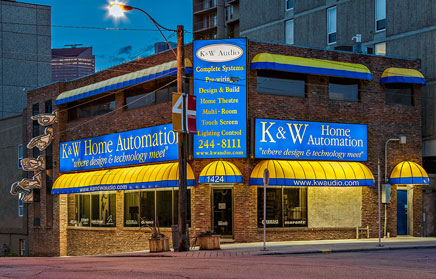TIP #20:
The big revolution in home audio for the 90’s has definitely been the Home Theatre Processor. Far and away the most popular choice in a home system’s power and control source has been the Pro-Logic receiver. These marvels of technology offer more bang for the buck than any regular receiver. There are many new controls and setup procedures not previously found on receivers. Extra amps, modes, and unique calibration needs can make that shiny new box seem like it may have been patterned after a more familiar one owned by some person by the name of Pandora.
So let’s go through the functions and procedures associated with integrating a Home Theatre Receiver with your system. For more information on receivers in general, refer to Tip # 16.
After opening the box and removing your new pride and joy, place it in your stand and get hookin’ up. The back panel may seem a little intimidating at first but, a methodical one step at a time approach will lead to a successful conclusion. Rather than looking at the back of the receiver, (undoubtedly the most connector filled unit in your system) look firstly to the components you want to hook up. With the CD player for example there are only two connectors on the back (Left and Right). Connect the cables into the back of the CD player (Right = Red), then look at the back of the receiver for the CD inputs and attach them. Following this, one unit at a time approach makes hookup a snap.
It is very important to be sure that left and right are never mixed up, as the surround sound effect can be decoded accurately by the processor only with the these connections correct. In addition bass will suffer with crossed connectors. Speaker hookup is the same, be sure all the plus and minus leads are in phase (Plus = Red) on both the receiver and the speakers. If this is not done, the processor will not sound focused and bass response will suffer.
Some advanced receivers will have on screen displays. In order to get the display on your TV you will need a monitor style TV (with patch type connectors as well as cable type). Usually it is the VCR’s picture coming through the receiver which allows us to have a display over the picture. In order to make this work, we must route the audio and video “out” patch cord type connectors on the VCR into the receiver (under the heading VCR 1 “in”) and from the receiver (VCR 1 “out”) back into the VCR (VCR “in”). We need the picture to go to the TV, so connect a video patch cable out of the receiver (monitor out) into the TV (Video in). Now when video is engaged on the TV, the receiver’s on screen information can be overlaid on the picture.
So you are all hooked up but not quite ready to go. There are still a few things to do to get optimum performance. First off, your receiver has a button labelled “mode”, which refers to the type of centre channel speaker you have chosen. If you have no dedicated centre channel, select the “Phantom” setting, I promise you that no guy in a mask will bother you. In this setting the receiver will route the Mono information, normally earmarked to go to a central speaker equally to both the right and left main speakers creating fake, or Phantom centre channel sound. If the speaker you have chosen for your centre channel is limited in its capabilities and will not handle deep bass, select the normal setting. Finally, if you have selected a high quality centre channel, capable of full range reproduction, select “wide”. This refers to wide band width, meaning the processor will feed all -frequencies including deep bass, to the centre speaker (for more information refer to Tip #12 on Effects Speakers).
Now you are ready to calibrate your receiver to the room. Hold it! Don’t throw this tip away and go hide, it’s really quite simple, just sit down in a comfy chair in front of the TV. Either your receiver or the remote control has a button labelled Test, press it. Hiss will now come from each speaker in the room, in turn. Next, turn the volume up to a level where you can easily discern differences in volume from each speaker. Adjust the volume levels on the centre and rear speakers so that the volume of hiss from then matches the volume of hiss from the main speakers. Now press test again to turn off the hiss, you are done.
The receiver now knows the room’s dimensions, where you are sitting, the efficiency of your speakers, and what your room sounds like – lots of stuff! Calibration is critical to get the best sound from your surround receiver. To reproduce the sound of a big movie theatre, an intimate jazz club or huge church it must know the characteristics of your room, to correctly adjust the sound to it’s new setting. Properly calibrated, a good surround processor could be in a huge hall or a shoe box, and its surround settings will sound equally as good.
You are now ready for years of wonder and joy from your surround receiver. Don’t be afraid to experiment, with all the available surround settings, on any source. Opera will sound great, in a concert hall setting, but it also sounds quite good in a jazz venue, and Van Halen in a church can be just as good as a rock concert. Experiment, you now are the acoustical engineer and the sky is the limit!


